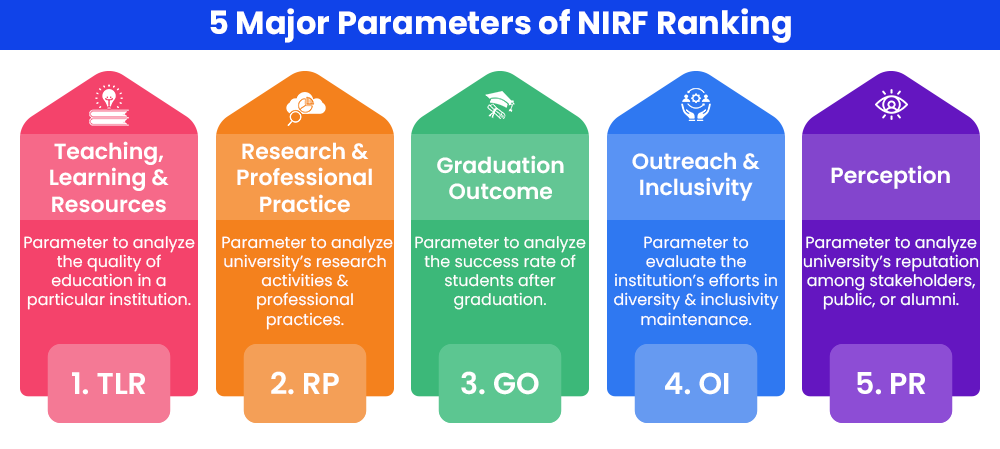Expert Interviews
- University Reviews
- Career Guide
 Video Counseling
Video CounselingImportant Facts
- Ask any Question - CV Forum

NIRF State Public University Ranking 2025 [Top 50 Universities]
Priya Pandey Sep 17, 2025 1.4K Reads

NIRF—National Institutional Ranking Framework is an initiative by the government of India, and it was launched by the Ministry of Education (formerly the Ministry of Human Resource & Development) in 2015.
It is a ranking methodology to rank higher education institutions on the basis of five major parameters, including, Teaching, Learning and Resources (TLR), Research and Professional Practice (RP), Graduation Outcome (GO), Outreach and Inclusivity (OI), and Perception (PR).
This methodology provides learners with great help, as through this method you can easily choose your dream university without any confusion or bias.
In this blog, we will learn about the state public university. Along with that, we will learn about those well-defined parameters in detail through which NIRF ranks colleges. And we will also learn about the top 50 state public universities ranked by NIRF in 2025. So! Let’s get started!
NIRF Ranking 2025 India: Top 50 State Public Universities
Since 2015, the NIRF has been releasing rankings lists of universities and colleges every year on the basis of overall performance, universities, colleges, engineering, management, etc. Similarly, this year they have released the list of the top 50 state universities.
Here is the list of the top 50 state universities ranked by the NIRF in the year 2025:
|
Institute ID |
Name |
City |
State |
Score |
Rank |
|
IR-O-U-0575 |
Jadavpur University |
Kolkata |
West Bengal |
76.08 |
1 |
|
IR-O-U-0439 |
Anna University |
Chennai |
Tamil Nadu |
76.06 |
2 |
|
IR-O-U-0078 |
Panjab University |
Chandigarh |
Chandigarh |
69.92 |
3 |
|
IR-O-U-0006 |
Andhra University, Visakhapatnam |
Visakhapatnam |
Andhra Pradesh |
68.91 |
4 |
|
IR-O-U-0260 |
Kerala University |
Thiruvananthapuram |
Kerala |
67.93 |
5 |
|
IR-O-U-0253 |
Cochin University of Science and Technology |
Cochin |
Kerala |
66.24 |
6 |
|
IR-O-U-0027 |
Osmania University |
Hyderabad |
Telangana |
65.64 |
7 |
|
IR-O-U-0196 |
University of Kashmir |
Srinagar |
Jammu and Kashmir |
65.17 |
8 |
|
IR-O-U-0052 |
Gauhati University |
Guwahati |
Assam |
64.24 |
9 |
|
IR-O-U-0447 |
Bharathiar University |
Coimbatore |
Tamil Nadu |
64.09 |
10 |
|
IR-O-U-0323 |
Savitribai Phule Pune University |
Pune |
Maharashtra |
63.58 |
11 |
|
IR-O-U-0318 |
Mumbai University |
Mumbai |
Maharashtra |
63.55 |
12 |
|
IR-O-U-0098 |
Delhi Technological University |
New Delhi |
Delhi |
63.50 |
13 |
|
IR-O-U-0435 |
Alagappa University |
Karaikudi |
Tamil Nadu |
62.82 |
14 |
|
IR-O-U-0570 |
Calcutta University |
Kolkata |
West Bengal |
62.75 |
15 |
|
IR-O-U-0448 |
Bharathidasan University |
Tiruchirappalli |
Tamil Nadu |
62.45 |
16 |
|
IR-O-U-0262 |
Mahatma Gandhi University, Kottayam |
Kottayam |
Kerala |
61.97 |
17 |
|
IR-O-I-1357 |
University of Madras |
Chennai |
Tamil Nadu |
61.43 |
18 |
|
IR-O-U-0105 |
Indraprastha Institute of Information Technology |
New Delhi |
Delhi |
58.12 |
19 |
|
IR-O-U-0235 |
Mysore University |
Mysuru |
Karnataka |
58.00 |
20 |
|
IR-O-U-0195 |
University of Jammu |
Jammu |
Jammu and Kashmir |
57.75 |
21 |
|
IR-O-U-0099 |
Guru Gobind Singh Indraprastha University |
New Delhi |
Delhi |
57.49 |
22 |
|
IR-O-U-0739 |
Madan Mohan Malaviya University of Technology |
Gorakhpur |
Uttar Pradesh |
57.48 |
23 |
|
IR-O-U-0003 |
Acharya Nagarjuna University |
Guntur |
Andhra Pradesh |
57.45 |
24 |
|
IR-O-U-0136 |
Gujarat University |
Ahmedabad |
Gujarat |
57.16 |
25 |
|
IR-O-U-0215 |
Bangalore University |
Bengaluru |
Karnataka |
57.04 |
26 |
|
IR-O-U-0524 |
University of Lucknow |
Lucknow |
Uttar Pradesh |
55.97 |
27 |
|
IR-O-U-0381 |
Punjab Agricultural University |
Ludhiana |
Punjab |
55.88 |
28 |
|
IR-O-U-0523 |
King George`s Medical University |
Lucknow |
Uttar Pradesh |
55.08 |
29 |
|
IR-O-U-0051 |
Dibrugarh University |
Dibrugarh |
Assam |
54.73 |
30 |
|
IR-O-U-0463 |
Madurai Kamaraj University |
Madurai |
Tamil Nadu |
54.37 |
31 |
|
IR-O-U-0162 |
Guru Jambheshwar University of Science and Technology, Hissar |
Hisar |
Haryana |
54.36 |
32 |
|
IR-O-U-0464 |
Manonmaniam Sundaranar University, Tirunelveli |
Tirunelveli |
Tamil Nadu |
54.14 |
33 |
|
IR-O-U-0443 |
Annamalai University |
Annamalainagar |
Tamil Nadu |
53.89 |
34 |
|
IR-O-U-0164 |
Kurukshetra University |
Kurukshetra |
Haryana |
53.56 |
35 |
|
IR-O-U-0200 |
Sher-e-Kashmir University of Agricultural Science and Technology of Kashmir |
Srinagar |
Jammu and Kashmir |
53.48 |
36 |
|
IR-O-U-0248 |
University of Agricultural Sciences, Bangalore |
Bengaluru |
Karnataka |
53.21 |
37 |
|
IR-O-U-0251 |
Calicut University, Thenhipalem, Malapuram |
Malappuram |
Kerala |
53.19 |
38 |
|
IR-O-C-6379 |
Netaji Subhas University of Technology (NSUT) |
Delhi |
Delhi |
53.17 |
39 |
|
IR-O-U-0470 |
Periyar University |
Salem |
Tamil Nadu |
52.96 |
40 |
|
IR-O-U-0506 |
Chaudhary Charan Singh University Meerut |
MEERUT |
Uttar Pradesh |
52.09 |
41 |
|
IR-O-U-0485 |
Tamil Nadu Agricultural University |
Coimbatore |
Tamil Nadu |
52.08 |
42 |
|
IR-O-U-1257 |
COEP Technological University |
Pune |
Maharashtra |
52.04 |
43 |
|
IR-O-U-0554 |
G.B. Pant Universtiy of Agriculture and Technology, Pantnagar |
Pantnagar |
Uttarakhand |
51.94 |
44 |
|
IR-O-U-0325 |
Shivaji University |
Kolhapur |
Maharashtra |
51.80 |
45 |
|
IR-O-I-1280 |
Maharshi Dayanand University |
Rohtak |
Haryana |
51.60 |
46 |
|
IR-O-U-0037 |
Sri Venkateswara University |
Tirupati |
Andhra Pradesh |
51.46 |
47 |
|
IR-O-U-0366 |
Utkal University |
Bhubaneswar |
Odisha |
50.53 |
48 |
|
IR-O-U-0270 |
Devi Ahilya Vishwavidyalaya |
Indore |
Madhya Pradesh |
50.41 |
49 |
|
IR-O-U-0249 |
Visvesvaraya Technological University |
Belgaum |
Karnataka |
50.28 |
50 |
What is a State Public University?
State Public Universities, or state universities, are public universities run by the state government of each of the states and territories of India and are usually established by a local legislative assembly act.
The University Grants Commission (UGC) draws its power from the University Grants Commission Act of 1956. These state universities are very beneficial for those who are looking for relevant universities within their states.

5 Major Parameters of Ranking Universities
The NIRF (National Institution Ranking Framework) has been ranking different universities on the basis of 5 major parameters including, Teaching, Learning and Resources (TLR), Research and Professional Practice (RP), Graduation Outcome (GO), Outreach and Inclusivity (OI), and Perception (PR). In this section, we will learn each of them in a detailed way.
1. Teaching, Learning & Resources (TLR)
This parameter judges the quality of education of a particular institution, how effective the learning environment is, and the availability of resources.
The components of Teaching, Learning, and Resources (TLR) are as follows:
|
S. No. |
Components |
Meaning/Define |
|
1. |
Faculty Quality |
It refers to the quality of the faculty, such as faculty or teachers’ qualifications and education. Furthermore, it emphasizes the quantity of the teaching faculty and the effective teaching methodology they are using to ensure a top-quality learning environment for the learners. |
|
2. |
Student Strength |
It refers to the total quantity of student enrollment in the university for post-graduation degrees, especially for masters and doctorates. |
|
3. |
Student Faculty Ratio |
It refers to the ratio of total students per teacher. It also emphasizes that every student is getting a quality education without compromising due to the overburden of students in a single class. |
|
4. |
Facilities & Infrastructure |
It refers to the number of facilities and quality of infrastructure provided by the university to the learner. |
|
5. |
E-learning Resources |
It refers to the e-learning resources or the latest learning or teaching technology implemented by the university. |
2. Research & Professional Practice (RP)
This parameter emphasizes primarily the quantity, quality, and impact of the research activities and professional practices implemented by the university.
The components of Research and Professional Practice (RP) are as follows:
|
S. No. |
Components |
Meaning/Define |
|
1. |
Publications |
It refers to the number of quality research papers published by the university in a reputed journal. |
|
2. |
Citations |
It refers to the number of times the university’s work is cited by other universities or institutions, indicating the authenticity of the university’s work. |
|
3. |
Research Funding |
It refers to the total amount of funding received by the university through the government or any private firm for research and other activities. |
|
4. |
Patents & Innovation |
It refers to the number of patents filed or granted and innovations done or startups built by the university. |
|
5. |
Collaborations |
It refers to the collaboration quality, like who are their collaborators and how they can impact the funding and other parameters of the university. |
3. Graduation Outcome (GO)
This parameter refers to the success rate of the students after their graduation, such as job placement, further education, etc.
The components of Graduation Outcome (GO) are as follows:
|
S. No. |
Components |
Meaning/Define |
|
1. |
Placement |
It refers to the percentage of students who got the job placement, in which industry they employed, the quality of their job role, etc. |
|
2. |
Higher Studies |
It refers to the percentage of students who choose to pursue their higher studies, like postgraduate or doctorate programs, after the completion of their graduation. |
|
3. |
Entrepreneurship |
It refers to the percentage of students or number of students who choose to do a business or become entrepreneurs after their graduation. |
|
4. |
Graduation Rate |
It refers to the number of students who complete their graduation in the stipulated time. |
|
5. |
Awards & Recognition |
It refers to the achievements of graduates in national or international competitions, awards, or recognition. |
4. Outreach & Inclusivity (OI)
This parameter evaluates how much the efforts put by the university in maintaining diversity and inclusivity. Along with that, social outreach or contribution to society, and so on.
The components of Outreach & Inclusivity (OI) are as follows:
|
S. No. |
Components |
Meaning/Define |
|
1. |
Women Representation |
It refers to the total percentage of female learners or teaching faculty members in a particular university. The measures taken by the university to promote gender diversity. |
|
2. |
Economically or Socially Disadvantaged Student Representation |
It refers to the total percentage of economically or socially disadvantaged students enrolled in a particular university, including EWS, ST/SC, etc. Along with that, the measures taken by the universities to provide them with proper facilities. |
|
3. |
Regional Diversity |
It refers to the ratio of students from the different geographical regions enrolled in a particular university. |
|
4. |
Facilities Provided To Differently-abled Students |
It refers to the total number of differently-abled students enrolled in the particular university. The measures taken by the university to provide them with proper help and facilities. |
|
5. |
Scholarships or Financial Help |
It refers to the scholarship facility or financial help provided by the university to support the studies of the learners. |
5. Perception (PR)
This parameter refers to the reputation of the university or institution among the outer world, like stakeholders, alumni, academic peers, and the general public.
The components of Perception (PR) are as follows:
|
S. No. |
Components |
Meaning/Define |
|
1. |
Academic Peer Perception |
It refers to the views of academic peers or institutions towards a particular university or academic institution. |
|
2. |
Employer Perception |
It refers to the opinions of the employers towards the employability of graduates, the relevancy of their education or the learning management systems of the university, etc. |
|
3. |
Public Perception |
It refers to the reviews of the general public towards a particular university or academic institution. |
|
4. |
Alumni Perception |
It refers to the reviews or ratings given by the alumni or ex-students of that particular university or academic institution. |
Online Degree/Certification Programs By State Public Universities Ranked By NIRF 2025
With the need of the moment, there is an initiative to provide online degree or certification programs by the government or private universities. Even now, top state public universities ranked by NIRF have started offering online courses in different subjects, such as management, computer applications, etc.
The initiative doesn’t benefit the institution financially, but it is also beneficial for those learners who want to pursue their degree or certification without relocation.
Conclusion
The NIRF Ranking of State Public Universities provides the learners with an insight into a particular university or institution so that they can pursue their higher education hassle-free. It provides significant insights into the institutions so that they can improve themselves in terms of faculty, learning facilities, financial, social, etc. The best thing about the NIRF ranking is that it allows the learners to choose the right university or institution according to their interests. So, if you are someone who will pursue your higher education this year and still have perplexion over choosing the best university, then consider the NIRF Ranking 2025 list now and choose the university that suits you the best!
FAQs (Frequently Asked Questions)
The NIRF (National Institution of Ranking Framework) is a ranking methodology to rank institutions of higher education in India. This is an initiative by the Ministry of Education (formerly the Ministry of Human Resources and Development) on 29th September 2015. The list of top institutions of higher education is released by the NIRF annually. Similarly, NIRF has released its list of top institutions of higher education for the year 2025, including top state public universities of India.
The NIRF Ranking matters a lot as it helps the learners to choose the best university or college to pursue their higher studies all over the country. Along with that, it facilitates the university by providing significant insights by ranking them annually so that they can improve in terms of learning facilities, teaching faculty, and other things.
The list of Top 10 State Public Universities ranked by NIRF 2025 in India is as follows:
- Jadavpur University
- Anna University
- IPanjab University
- Andhra University, Visakhapatnam
- Kerala University
- Cochin University of Science and Technology
- Osmania University
- University of Kashmir
- Gauhati University
- Bharathiar University
The NIRF Ranking is calculated on the basis of 5 major parameters:
- Teaching, Learning and Resources (TLR)
- Research and Professional Practice (RP)
- Graduation Outcome (GO)
- Outreach and Inclusivity (OI)
- Perception (PR)
The categories of NIRF Ranking are as follows:
- Overall
- University
- College
- Engineering
- Management
- Open Universities
- State Public Universities and so on.

By Priya Pandey
8 Years of Experience / Storyteller / Research-driven Writer
A passionate content marketer with a keen understanding of audience psychology and a flair for storytelling. Love to transform complex ideas into engaging content for targeted audiences. Use a creative approach for each project and deliver it with precision, ensuring that every piece of content not only educates but also inspires action.
Every query is essential.
Our team of experts, or experienced individuals, will answer it within 24 hours.
Recommended for you
Tired of dealing with call centers!
Get a professional advisor for Career!
LIFETIME FREE
Rs.1499(Exclusive offer for today)

Pooja
MBA 7 yrs exp

Sarthak
M.Com 4 yrs exp

Kapil Gupta
MCA 5 yrs exp
or



Career Finder
(Career Suitability Test)
Explore and Find out your Most Suitable Career Path. Get Started with our Career Finder Tool Now!
ROI Calculator
Find out the expected salary, costs, and ROI of your chosen online university with our free calculator.
